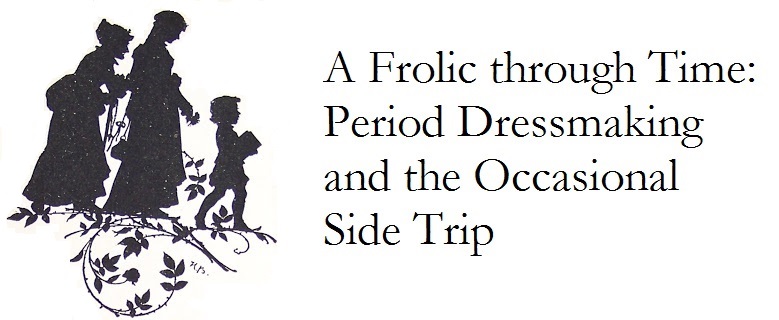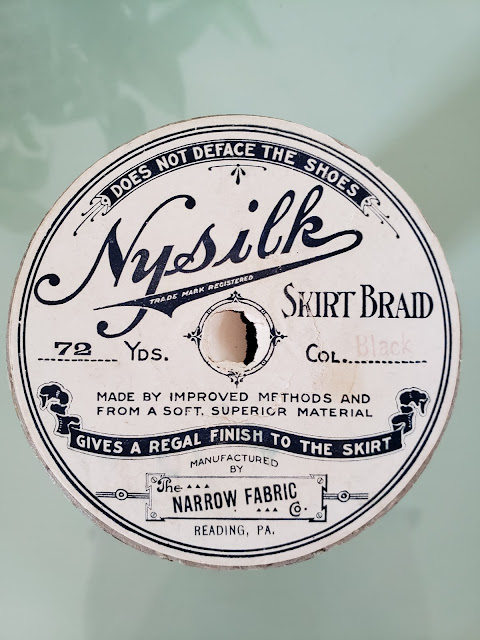 |
| A Christmas gift? No, a Christmastime project. |
Sometime in 2014, during the lilac-colored silk phase in which I made an embroidered 1790s sleeveless spencer, matching outer petticoat, and pearled headband after an original, I started a beaded reticule project. It stalled and was picked up and dropped again during the following decade, and only now have I finished it. During that time I went through several phones and it appears photos documenting the project's early days have gone missing, so the following is a somewhat truncated history of its making.
First, Why the Lack of Posts for So Long?
It's not for lack of making things, for I did manage a pair of 1790s stays, a velveteen spencer, and a pretty apron-front dress. Those projects, though, happened in short spurts that felt like shelter from repeated storms. There was another health situation, one in the long series that have punctuated the last 30 years, and then, the illness and passing of my darling and beloved father, followed months later by my sweet aunt. Last spring saw my sisters and I sharing taking 24-hour care of our daddy during his time in hospice and helping our stepmother/mother through, and then, the loss, the mourning... Losing a parent is a loss apart; it shakes the foundations. It's still too close for elegy, except to say that his community lost a dedicated volunteer and leader and we lost a mentor, a guide, a loving father and friend. Even now I can hear his voice.
The Finished Reticule
Nuts, I don't want to write again, but, he thought hobbies were key to mind and soul, so, let's go. Here is the completed reticule. It measures 9 inches at its widest by 9 inches tall and a measly 1.25 inches deep. It's deep enough to hold a small fan, a handkerchief, smelling salts and a phone. I suppose it's possible that you'd find lip gloss and some cash, too, were you to snoop. I wanted it big enough to be useful, but not big enough to become lumpy with the thinggummies that naturally accumulate in my own purse, for practicality and so I have the satisfaction of pulling out whatever's needed like a rabbit out of a hat when my sons or husband ask. Package of band aids, mini containers of sunscreen, lotion, and hand sanitizer, a pen, sunglasses, a scrap of paper for writing, a tiny measuring tape, lactose pills for the lactose-intolerant son, emergency migraine tablet, tissues, keys...all in the smallest package I can manage. Query: did Regency women do similarly? Were smelling salts part of a reticule's community of objects?
 |
| The front, natch |
 |
| The back and the compound strap |
 |
| The narrower-than-wanted interior |
The reticule has stiff sides, courtesy interior cardboard on back and front, softened with millinery domette so that the surface doesn't feel harsh.
Intermission for Kitty Cuteness
 |
"Why are you putting that thing on top of me?" asked Nutmeg,
who was on my lap. |
How It Was Made
The shape is fairly common for the Regency period, interesting visually because most sides are at oblique angles. I saw an example in 2014 with similar beading and loved it. The photo once lost, I never found it or was able to track it down online again. Then, a year or so ago, one so like the original turned up in a favorite Etsy shop (GraceofTime) that it was quick like a bunny -- save the photo! Here it is.
 |
| Reticule from Graceof Time on Etsy: their photo |
This reticule I think is padded, and soft-sided, and seems mostly to be beaded in white and silver, and the fabric may be a satin. Still, you see the resemblance.
I wanted flat sides as my other reticule gets so shapeless and lumpy when anything is put inside, plus the tailored look is attractive. Dangling beads were not to be thought of; a klutz, I'd catch a loop on something for sure and beads would fly.
The construction is invented because I'd no access to originals. It uses stitches common in the Regency period: back-stitching for strength, whipping of seams, hemming.
Materials
- Exterior fabric: home-dyed silk shantung from Dharma Trading
- Interior fabric: undyed silk shantung, ditto
- Stiffener: cardboard from a discarded cereal box
- Soft interlining: domette, I think from Judith M millinery in Shelbyville, KY
- Beads: pearl seed beads, gold-interior clear sead beads: the color isn't warm
- Embroidery silk: Au Ver a Soie silk ovale, a flat, untwisted filament silk (not spun and a joy to use)
- Sewing thread: vintage British sewing silk in Heliotrope
- Strap: tawny silk cord and silk tassels from a deconstructed remnant of antique passementerie whose connecting threads had shattered, from DuchessTrading on Etsy. The passementerie was too far gone to edge a gorgeous pillow, so...creative reuse.
The Beading
I drew the design on paper, then copied it on the home-dyed silk shantung. The fabric was tightened in an embroidery hoop: this sort of work cannot be easily done on fabric that isn't taut. Then I sewed the stems in elongated chain stitch.
Each beaded twig or frond was made in one go, by pulling the thread up through the fabric, loading the thread with the requisite number of beads, laying it flat, and running the needle back into the fabric. Then, with a second needle, couching down the longer threads every few beads as invisibly as possible. Otherwise, they became droopy and at risk of being pulled off.
The Assembly and Sewing
After beading the fabric, I sketched and cut out pattern shapes for the back, which included the foldover flap, and the front, which included an extra piece at the bottom to make the bottom a little deep, front to back. You know, for stuffing stuff into the purse. It's likely I cut out more than one pattern, to see which size felt most natural and useful.
Once happy with the pattern, the fashion fabric and lining were cut out, using generous 1-inch seam allowances.
I used a leftover breakfast cereal box, which is a single layer of cardboard, not terribly heavy, to cut a back (minus the foldover flap) and a front.
Lastly, I cut millinery domette according to the pattern pieces as a nice soft interlining to make the purse feel good to hold.
The lining for front and back were laid flat, the carboard laid atop, then the domette went on that, and the fashion fabric over all. The layers were pinned and basted securely in red thread so that I could easily see it to pull it out later.
 |
| You can see the three layers in the flap: fashion fabric, domette, lining. |
At this point there was a great deal of dithering and it's likely that the dithering precipitated one of the laying-aside periods. I had thought I was going to simply sew the front and back together. However, alert readers will envision me trying to reach into the reticule and finding it hard to insert more than a slip of paper, even with that excess bit at the bottom that was supposed to offer some room. Those hard sides didn't give. No room, no room at all! I'd need to add sides...
Eventually I determined to cut probably 2-inch wide pieces (1/2-inch seam allowance) to insert between front and back. At this remove I can't figure out what made me cut separate pieces for the long sides and the short sides, but that's what happened.
To seam the sides to the front and back, I chose to turn the seam allowances inward of all fabric pieces and whip them together with very close stitches, about 1/8 inch apart. This makes the seam stand in a little ridge, with little fabric bumps between each stitch that echo the beading. It's also good and strong. It does mean, however, that the interior lining has raw edges. The silk doesn't fray much at all, so am not concerned about that. I probably should have seamed up the lining separately and slipped it in, though...
 |
Seaming together front and back. You can see the
side pieces have been whipped on to the front. |
The fashion fabric, domette, and lining for the flap were laid together, then the fashion fabric seam allowance was turned in over the domette and basted.
The strap, which is made up one long piece of cord folded into the three, was laid across the flap at the spot where it folds over from the back piece, and on top of the domette. The lining seam allowances were turned in, just a hair inside the fashion fabric so that it wouldn't show on the outside and laid atop. More basting to hold everything smooth. Puckering would have been fatal. That's too dramatic, of course, but by now it was at the end of 2023 and I didn't want to end on a whimper. The lining was carefully hemmed to the fashion fabric.
All that was left was to turn in the edges of the sides at the reticule's opening and hem them, though I did have to do a bit more seam whipping at the opening, since I winged (wung? Oh, those irregular verbs) the strap at the last minute. It had taken a year or two to find, hunting on and off, the right strap. I couldn't find any thick silk cord that was remotely affordable in the right color, found the artificial silk cords too bright and slick and shiny to work with the nearly matte shantung, and just didn't want ribbon.
Is a tasseled strap appropriate? Yes, but I've never seen a reticule strap so loaded with them. But, they're in the spirit of the 1790s: out-and-out luxury, outre attitudes, and caution to the winds.
So there it is. My only concern? The cardboard interior is just cereal box. If that's made of wood cellulose, which is likely, it may break down over time. With care, the rest is good for ages and ages.
All in all, this was a good project. Contained, full of challenges and design puzzles. I'd should have made the sides a little wider, and that cardboard should have been archival pasteboard, but that's small stuff. Here's to having a fun, fluffy, shiny reticule to carry.
Today I leave you with a little cat TV. Ciao until next we meet!







.jpg)













































